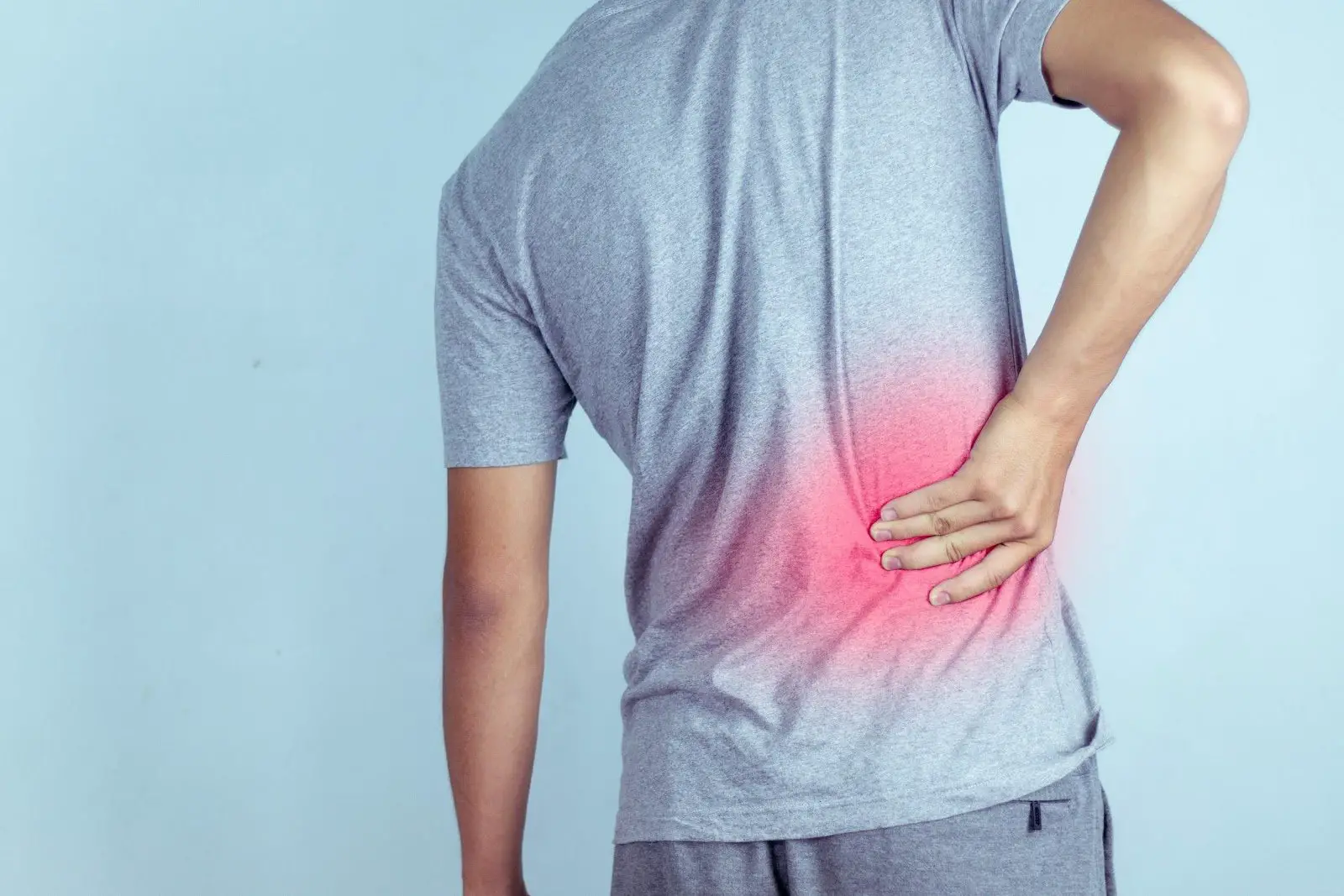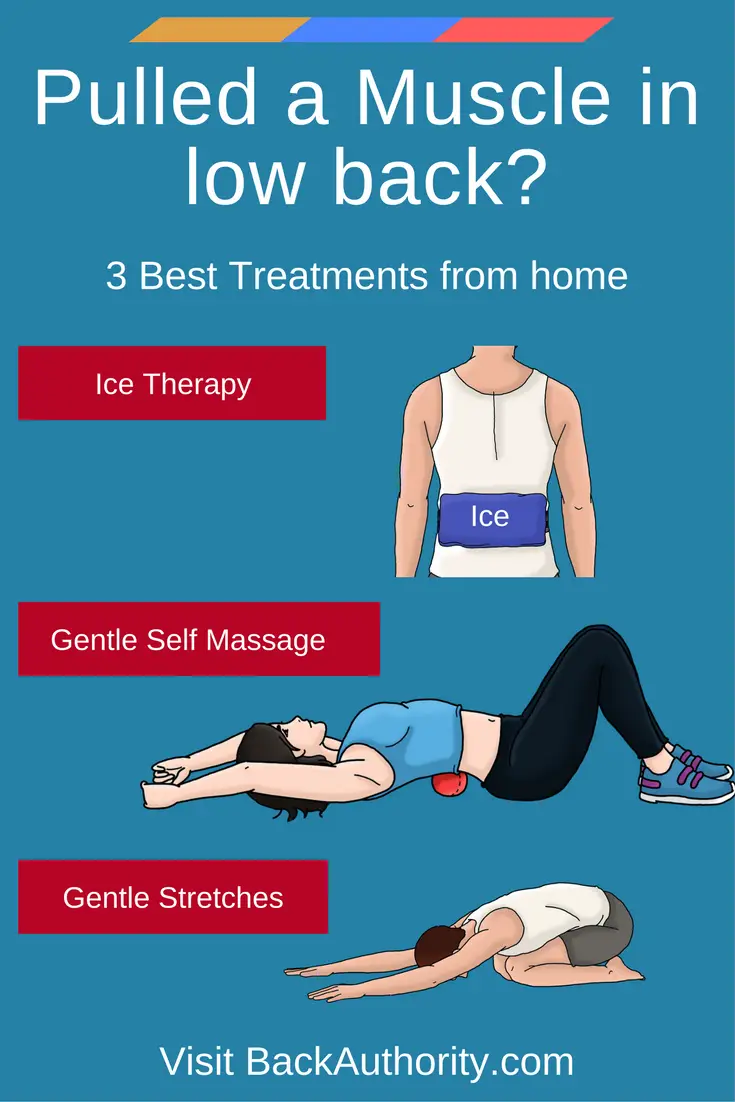Rest And Give It Time
Rest But Not Too Much
Dont rest too long. A little couch time wont hurt, but light activity speeds recovery, so avoid lying down for long periods of time.
Growing evidence shows there is little or no benefit to bed rest over staying active.
So use this rule of thumb: listen to your body.
Ultimately, your level of pain will determine your level of activity.
If a certain activity led to a pulled muscle dont repeat it for at least a week.
For example, if your back pain started after lifting something heavy, avoid lifting heavy objects for at least a week while your pulled back muscle heals.
Also, avoid sitting for too long. Long periods of sitting can tighten your muscles and cause lower back muscle pain and stiffness.
When you sit and stand, use good posture, avoiding slumping in your head and shoulders.
Read Also: What Should I Do For Back Pain
How Is Lumbar Strain Treated
Specific treatment for a lumbar strain will be discussed with you by your healthcare provider based on:
- Your age, overall health, and medical history
- Extent of the injury
- Your tolerance for specific medicines, procedures, and therapies
- Expectation for the course of the injury
- Your opinion or preference
- Ice packs and/or heat and compression applied to the back
- Exercises
- Stretching and strengthening exercises
- Education regarding the use and wearing of appropriate protective equipment
Medicines, such as anti-inflammatories and spinal injections, may also be used to relieve pain and inflammation.
Also Check: Why My Lower Back Hurts When I Sit
Stretches To Heal Your Sore Back Muscle Pain:
Knee to Chest Stretch:
While lying flat on your back, have your toes point to the sky. Slowly bend your left knee and pull your leg close to your chest. Place your arms around your thigh or knee and pull it towards your chest. Hold this position for 10 seconds, repeat with the other leg.
Double Knee to Chest:
Start by lying on your back with both of your knees bent and feet flat on the floor. Next, slowly raise both of your knees to your chest, holding them with your hands. Pull your knees up so they are close to your chest and hold here for around 10 seconds then repeat.
Hip Stretch:
While standing with your feet shoulder-width apart, take a step back with your right foot. Bend your left knee and shift weight back to the right hip. While keeping the right leg bent at a 90-degree angle, bend forward more and reach down the right leg until you can feel your outer hip stretch. Repeat with the other leg.
Cat/Cow Stretch:
Start by kneeling on all fours with your hands directly below your shoulders and your knees lined up with your hips. While doing a large exhale, arch your spine slowly. As you inhale, use your core to round your back . Repeat this motion about 10 times.
Muscle Strain Or Injury

A spasm in the back can occur as the result of any type of strain or injury to the soft tissues of the back, including the muscles, ligaments, and tendons. For example, heavy lifting, as well as sports that involve sudden and repetitive movements, are common causes of muscle spasm in the back. However, any type of activity that puts excessive strain on the muscles of the back can lead to an injury, and subsequently muscle spasm.
Also Check: Advil Or Ibuprofen For Back Pain
Read Also: Can Ms Cause Back Pain
What Are The Symptoms Of A Strained Back
Symptoms of a strained back include:
- Stiffness in the lower back with range of motion reduction
- Muscle spasms at anytime
- Low back pain that can spread to the buttocks
- Stiffness and pain that prevents normal posture
- Pain that lasts for up to two weeks
Other conditions may mimic back strain symptoms. Infection in the lower back caused by osteomyelitis or an abscess can seem like back strain. Also, kidney conditions like kidney stones can cause back pain. Inflammation of the prostate in men and pelvic inflammatory disease in women can also mimic strained back pain. You should visit your doctor if your symptoms do not resolve in a few weeks.
How Are Back Strains And Sprains Treated
The treatment for strains and sprains is similar, and often takes place in two phases.
The goal of the first phase is to reduce the pain and spasm. This may involve rest, and the use of ice packs and compression , especially for the first 24 to 48 hours after the injury. An over-the-counter nonsteroidal anti-inflammatory drug, such as ibuprofen , may be recommended to help reduce pain and swelling.
After the first 24 to 48 hours, returning to normal activities, as tolerated, is advisable. Extended bed rest or immobility simply prolongs symptoms and delays recovery.
Most people with lumbar strain/sprain symptoms improve in about 2 weeks. If symptoms continue for more than 2 weeks, additional treatment may be required.
Recommended Reading: How Does Heat Help Back Pain
Understanding Lower Back Strain
Most episodes of acute lower back pain are caused by damage to your soft tissues, or the muscles and ligaments that support your lumbar spine.
This type of injury is called a lower back strain, but its popularly referred to as a pulled muscle. The pain resulting from a lower back strain can be surprisingly severe, sending many patients to the emergency room.
Your back is supported by a large, complex group of muscles that hold up the spine. Watch: Lower Back Strain Video
Our animated video on lower back strains can help you better understand this type of injury.
See Sport Injuries, Back Injuries, and Back Pain
How To Recover From Deadlift Lower Back Injury: Conclusion
Some exercises are a little riskier than others. The deadlift is one of them. But many people deadlift safely and properly every day without experiencing injuries. If you find yourself with a deadlifting injury, follow the directions above and ask yourself if youre doing the exercise properly. Ask a personal trainer or a knowledgeable friend to analyze your form and give you pointers so you dont injure yourself in the future.
If your form is good, talk to a chiropractor about your posture and your back. Weak muscles and a misaligned spine may also contribute to deadlifting injuries and should be corrected as soon as possible.
Resources:
Dont Miss: Are Memory Foam Mattresses Good For Lower Back Pain
Also Check: How To Loosen Your Lower Back
More Ways To Prevent Future Back Spasms:
Maintain a healthy weight if youre overweight, you increase the stress on your spine and joints.
Improve your posture improper postures such as being hunched over all day can increase your risk of back spasms. Ensuring that you maintain proper posture, and using ergonomic aids when needed provide the stability and strength that your back needs and minimizes your risk of back spasms.
Exercise regularly engaging in a stretching and strengthening program for your back and core muscles, and regularly participating in some form of cardiovascular activity, will help to keep your back healthy and minimize your risk of back spasms.
Warm up and cool down before exercising properly warming up and cooling down before and after exercise can help prevent your muscles from becoming fatigued, strained, or injured. Before working out, try jogging in place and doing sport-specific movements that help to get your heart rate up and blood flowing to your muscles, ligaments, tendons, and joints. After your work out, take about 10 minutes to stretch the major muscle groups of your body to help prevent muscle spasms.
Stay hydrated dehydration can lead to muscle spasms. Ensure that youre consuming enough water for your body size and activity level helps to minimize your risk of back spasms.
When To See A Doctor
If the pain has not eased after 12 weeks, a person should see a doctor.
In some circumstances, a person may need to go to the emergency department or call 911. It is important to seek medical help if:
- a person hears a crack when they sustain the injury
- the injured part of the back is numb, discolored, or cold to the touch
- sit in a chair with lumbar support
The following tips may also be beneficial:
Don’t Miss: Which Tens Machine Is Best For Back Pain
Left Side Low Back Pain
Many people experience muscle pain on only one side of their back. This can be due to compensating for a sore joint, like a hip or knee. For example, if one of your hip joints is weak, you may be putting strain on the opposite side of your lower back to make up for that.
However, lower back pain on your left side may also be due to:
If you do pull a lower back muscle, there are several things you can help relieve the swelling and pain.
Find A Physical Therapist In Chicago

If youre an athlete experiencing lower back pain, get the relief you need at IMPACT Physical Therapy. With over 20 years of experience, our focus is to get to know you as a person to identify your specific needs and goals. With hands-on treatment, well work with you to reduce your lower back pain and get you back in the game. Contact us today to schedule an appointment with one of our experienced physical therapists.
Read Also: Does Glucosamine Help With Back Pain
What Causes A Back Strain
The lower back is a common place for a muscle strain because of its workload. It supports the weight of the upper body while twisting, bending, and moving. The strain happens when fibers in the muscle are irregularly torn or stretched. Sometimes ligaments are also torn from their attachments. Strains can result from an abrupt injury or muscle overuse over a period of time.
Small injuries may also come from falling or twisting of the spine. More serious injuries can come from trauma to the head, car accidents, or falls from heights. A stab wound or other direct injury to the back can also lead to strain and pain.
Rest And Ice Or Heat Therapy
The final step in this treatment process involves resting, using ice and heat therapy, and prevention methods to reduce the chance of straining your back again. Read more about the R.I.C.E. method here.) Its no surprise that the benefit of resting during the recovery process is to help give your muscles a break from the work they typically endure every day. But this part can be a tricky as most doctors suggest you do not completely do bed rest but that you lower the number of activities instead.
Ice and heat therapy is a crucial part of treatment for your back muscle relief. Using heat can help open up your blood vessels, which promotes healing in your tissues, tendons, and muscles. Ice, on the other hand, narrows your blood vessels, which helps to reduce any swelling that you might be suffering from. Using a heat and ice therapy wrap can help you easily switch from applying hot and cold to your lower back.
And finally, another aspect of this step involves prevention methods to help you avoid straining, pulling, or tearing your back in the future. There are many different ways to help prevent a pulled back muscle including:
- Sleep on your back or side
- Avoid smoking
- Correct your posture. Try using a posture brace like this one to train your muscles to remain in the right position
Read Also: Do Inversion Tables Work For Lower Back Pain
Where Can I Get More Information
For more information on neurological disorders or research programs funded by the National Institute of Neurological Disorders and Stroke, contact the Institute’s Brain Resources and Information Network at:
Office of Communications and Public LiaisonNational Institute of Neurological Disorders and StrokeNational Institutes of HealthBethesda, MD 20892
NINDS health-related material is provided for information purposes only and does not necessarily represent endorsement by or an official position of the National Institute of Neurological Disorders and Stroke or any other Federal agency. Advice on the treatment or care of an individual patient should be obtained through consultation with a physician who has examined that patient or is familiar with that patient’s medical history.
All NINDS-prepared information is in the public domain and may be freely copied. Credit to the NINDS or the NIH is appreciated.
Treatments For Lower Right Back Muscle Strains
Lower back pain is the reason most people schedule a visit to their doctor. While herniated discs and pinched nerves can be a source of such discomfort, strain on muscles that have been overused, over-stretched, or damaged is often the culprit. Symptoms such as sharp, sudden pain triggered by movement are often localized to the lower right back or similar area. Regardless of the specific location, most instances of muscle strain arent serious. Santa Monica spine surgeons discuss a few things that can be done to find much-appreciated relief from lower right back muscle strain.
You May Like: How To Relieve Intense Lower Back Pain
How Long Does It Take For A Strain To Heal
The majority of back strain pain will go away without help in one to four weeks. Of the cases that are seen in hospital emergency rooms, most can be dealt with conservatively. You must pay careful attention to easily seen warnings that can mean something more serious is going on.
If the pain lasts more than two weeks without at least easing up somewhat, you should seek medical attention. There may be a more serious injury to the muscles supporting the spine. These muscles include:
- Flexor muscles like the abdominal muscles
- Extensors like the gluteal muscles
- Obliques or side muscles
Overall, most acute occurrences of back pain resolve within twelve weeks, though about a third of patients could have long-term symptoms. Management of back strains depends on a lot of things, including:
- Type of symptoms
Types Of Treatment For A Pulled Lower Back Muscle
A pulled lower back muscle is debilitating enough to keep you out of your favorite activities for a few days or even weeks. It can be very frustrating, especially if you are just setting out to achieve one of your fitness goals. Thankfully, this is a very common injury and easily treatable, unless you have a severely pulled muscle.
Video of the Day
You May Like: What Doctor Do You See For Back Pain
Essential Oil Soothing Muscle Rub
Another way to help take the pain out of strained back muscles is to make your own soothing essential oil muscle rub. Many essential oils have properties that relax damaged and irritated muscles and tendons. Also, the massaging process helps to stimulate blood flow and reduce the time a pulled muscle takes to heal.
For example, a study in 2016 found that a mixture of lavender, rosemary, and peppermint essential oils helped to reduce chronic shoulder pain in 30% of people who used it.16
How to use essential oils for back pain relief:
If you have pulled a muscle in your back, you should make your own pain-relieving massage oil to help heal a pulled back muscle. This is what you should do:
Try Doing Gentle Back Stretches

You May Like: When To See A Dr For Back Pain
What Does Pulled Strained Or Torn Muscle In Back Feel Like
The symptoms of a strained, pulled, or torn muscle depend much on the cause of the injury and the extent of muscle damage. Doctors from the Mayo Clinic say that a strained muscle will feel painful and sore and you may notice some swelling around the injured area.
Dr. Lawrence Gulotta, a sports injury specialist, says that muscle injuries can be divided into 3 grades:3
Grade 1 strained back muscle. This will cause mild pain as just a small percentage of muscle tissue is damaged. You will only have minimal loss of motion in your back. Injuries that strain back muscles take about 2-3 weeks to heal if they are treated properly.
Grade 2 pulled back muscle. Severely pulling a back muscle will result in intense pain and can also cause some of the back muscles to tear. A severely pulled trapezius, rhomboid, or latissimus dorsi muscle will take between 2 and 3 months to completely heal.
Grade 3 torn back muscle. If the back muscle gets completely torn or ruptures, this will cause you to feel severe pain and discomfort. It will take many months to heal the torn muscle and in some cases, may take surgery to repair the muscle tear.